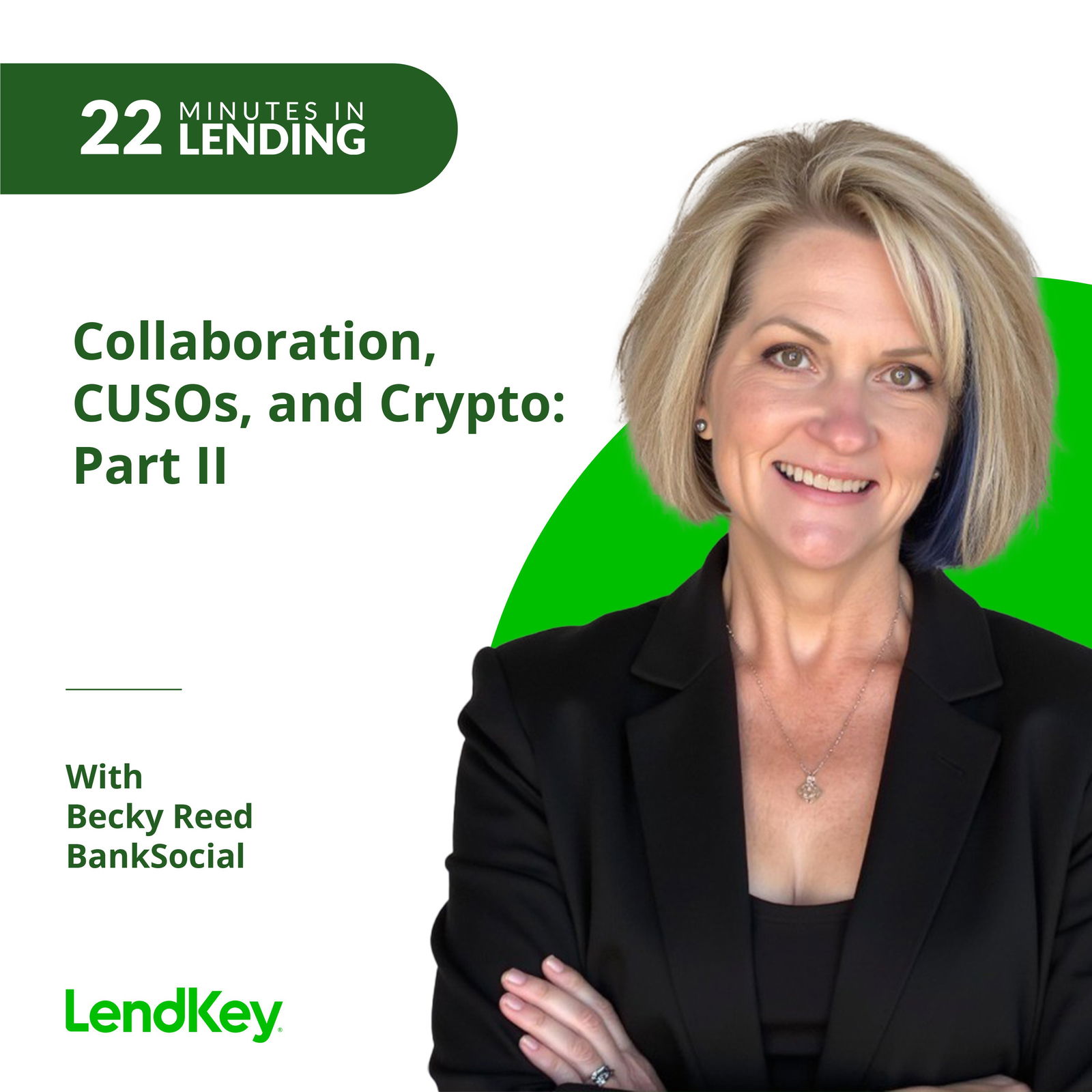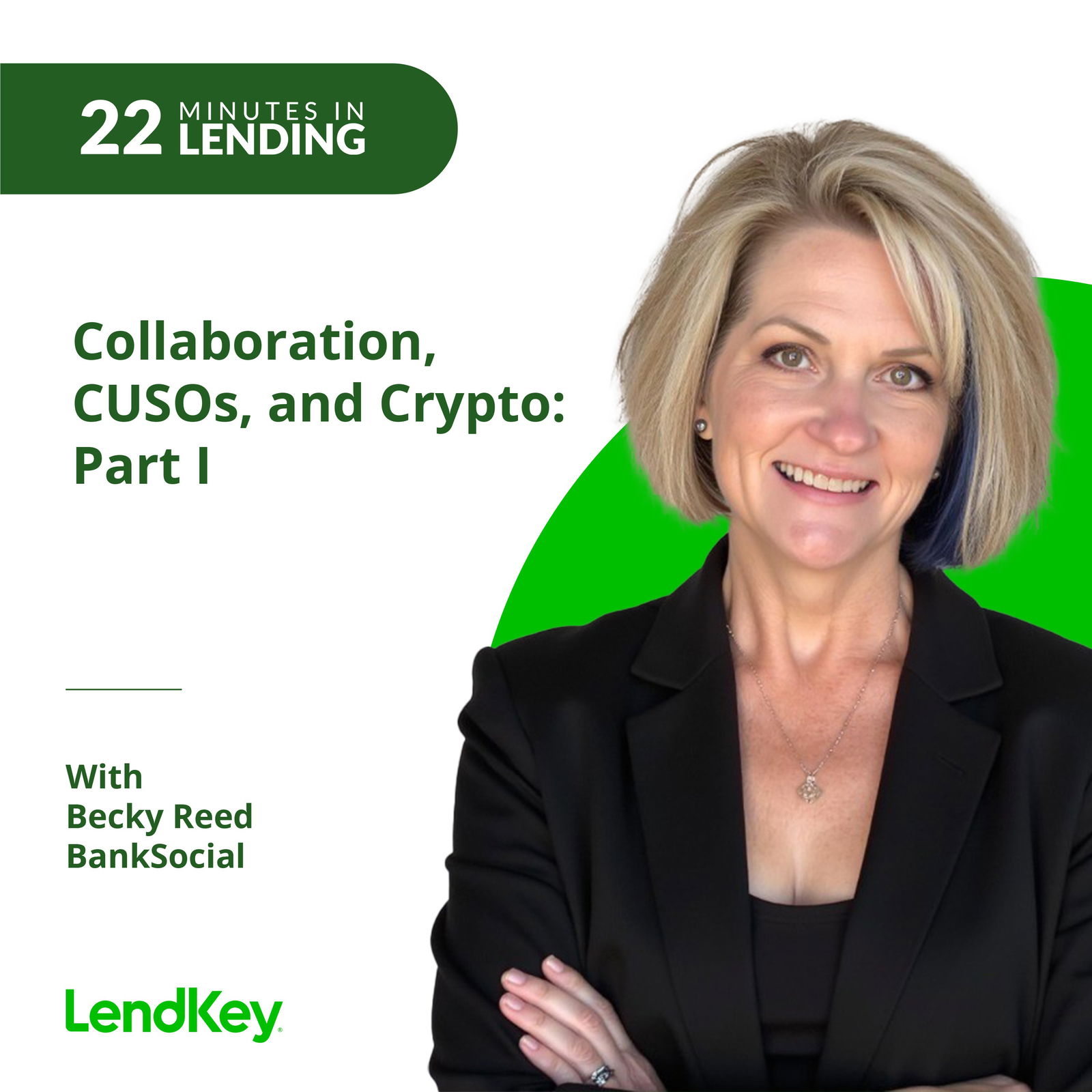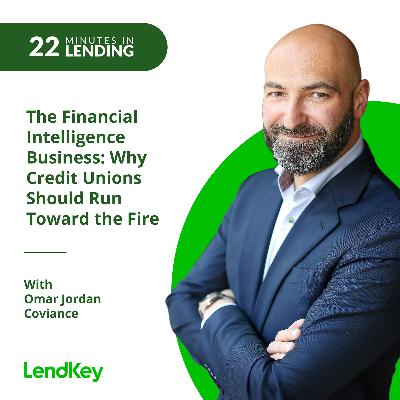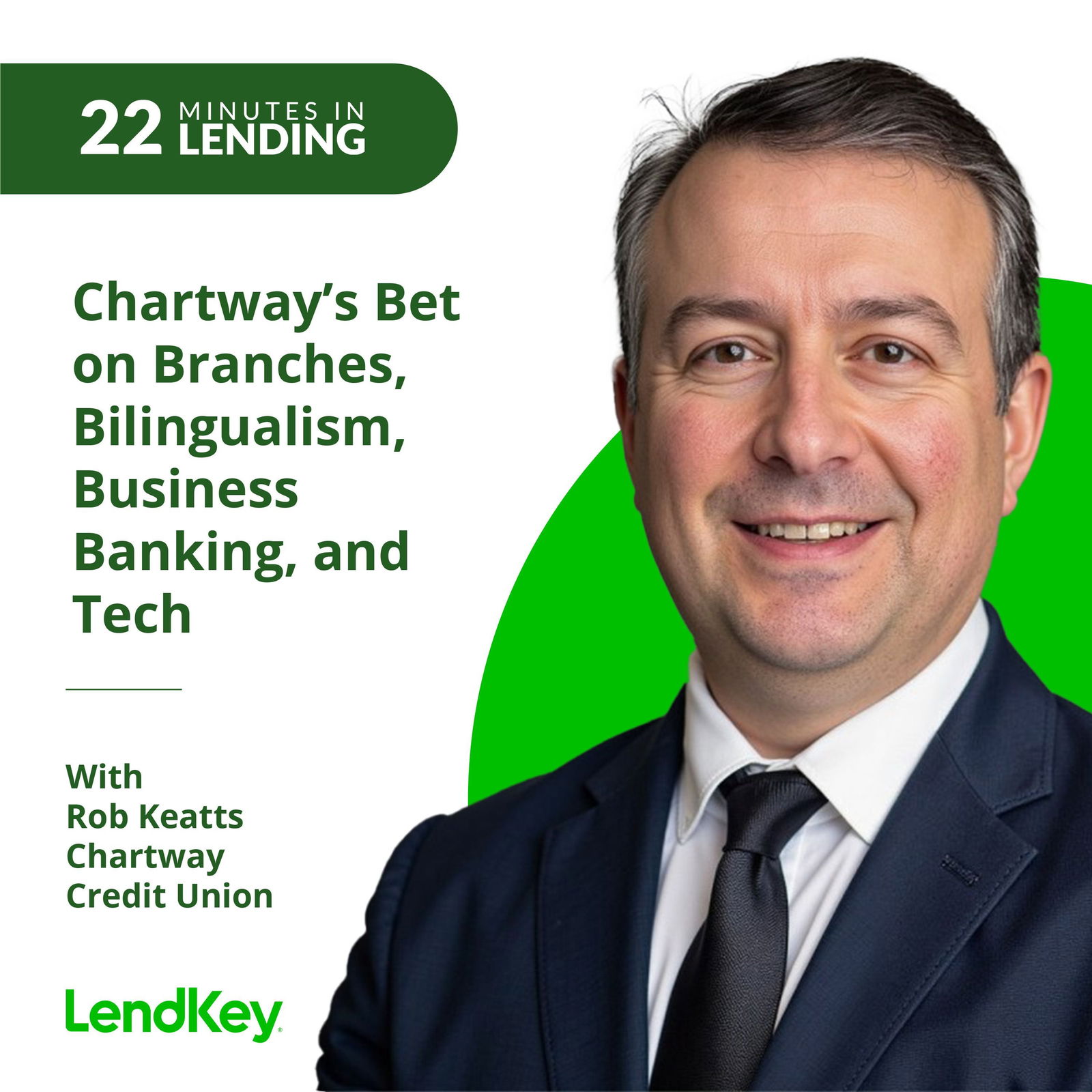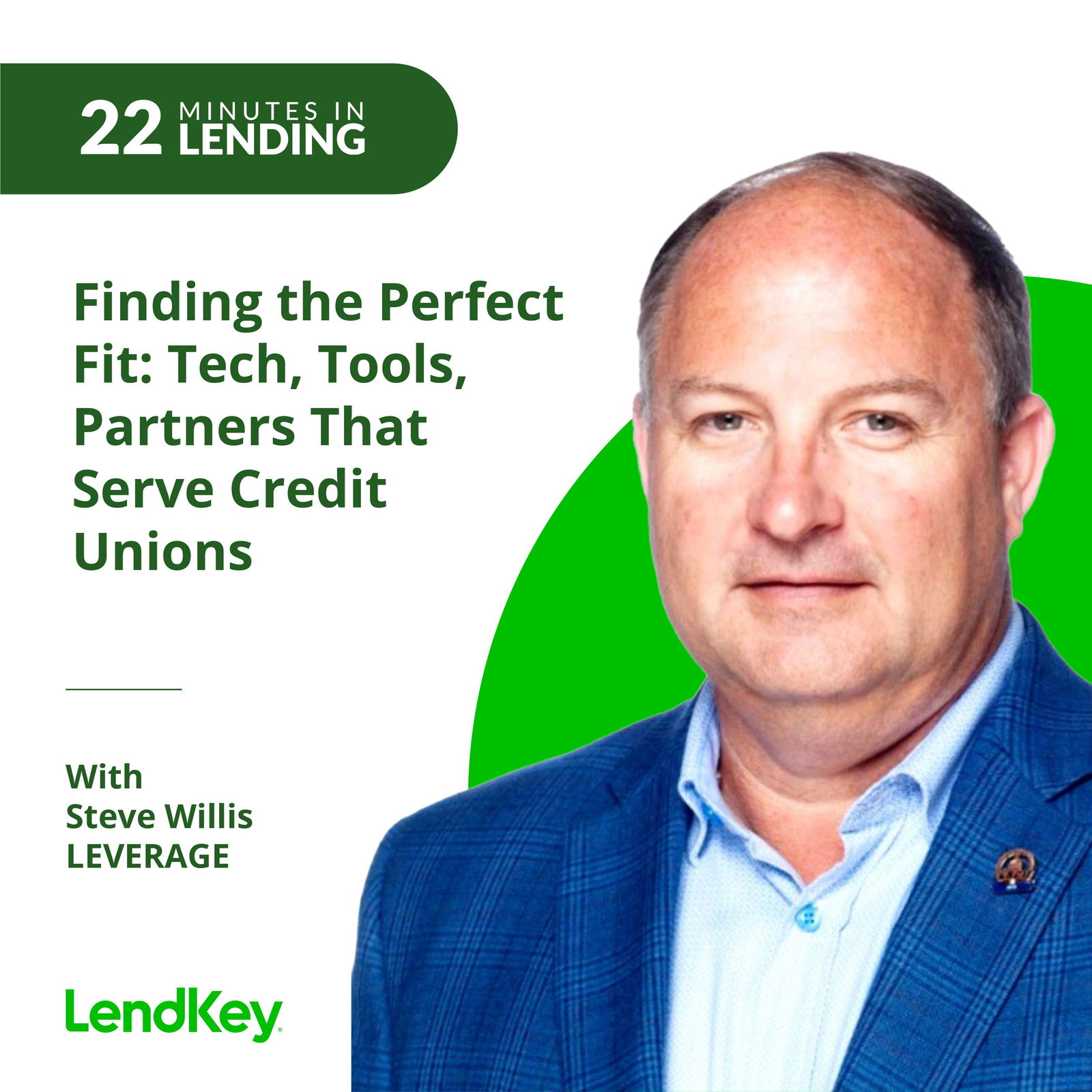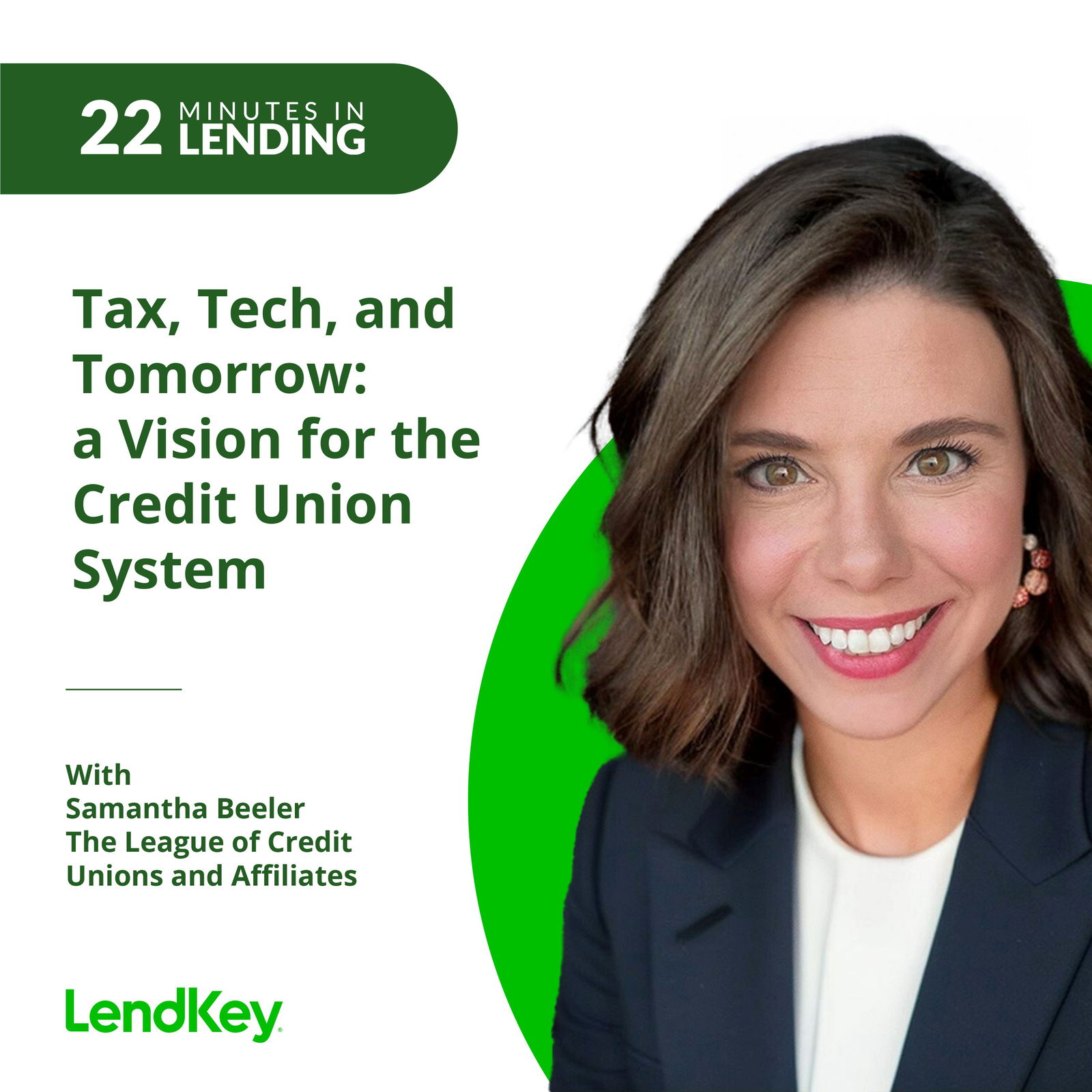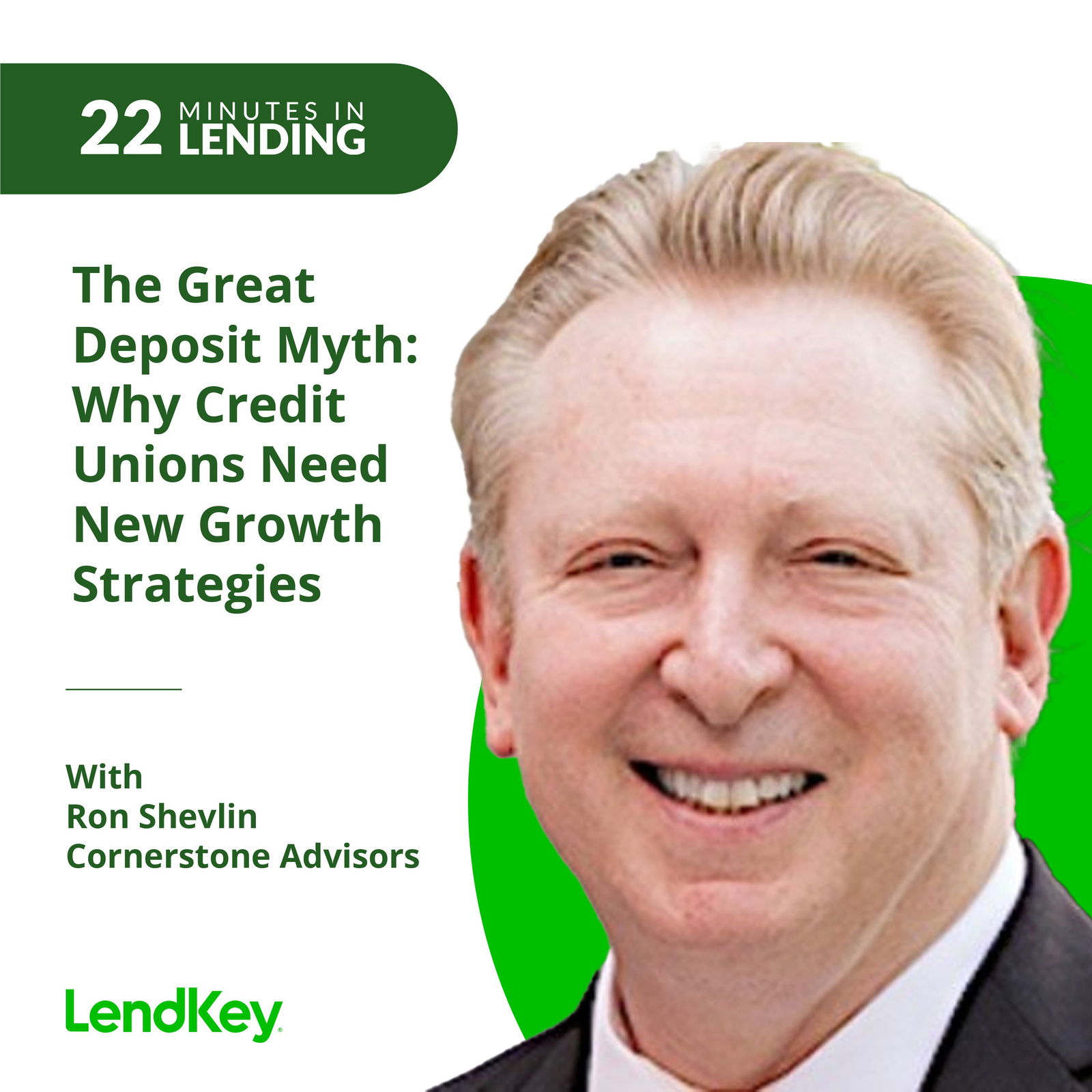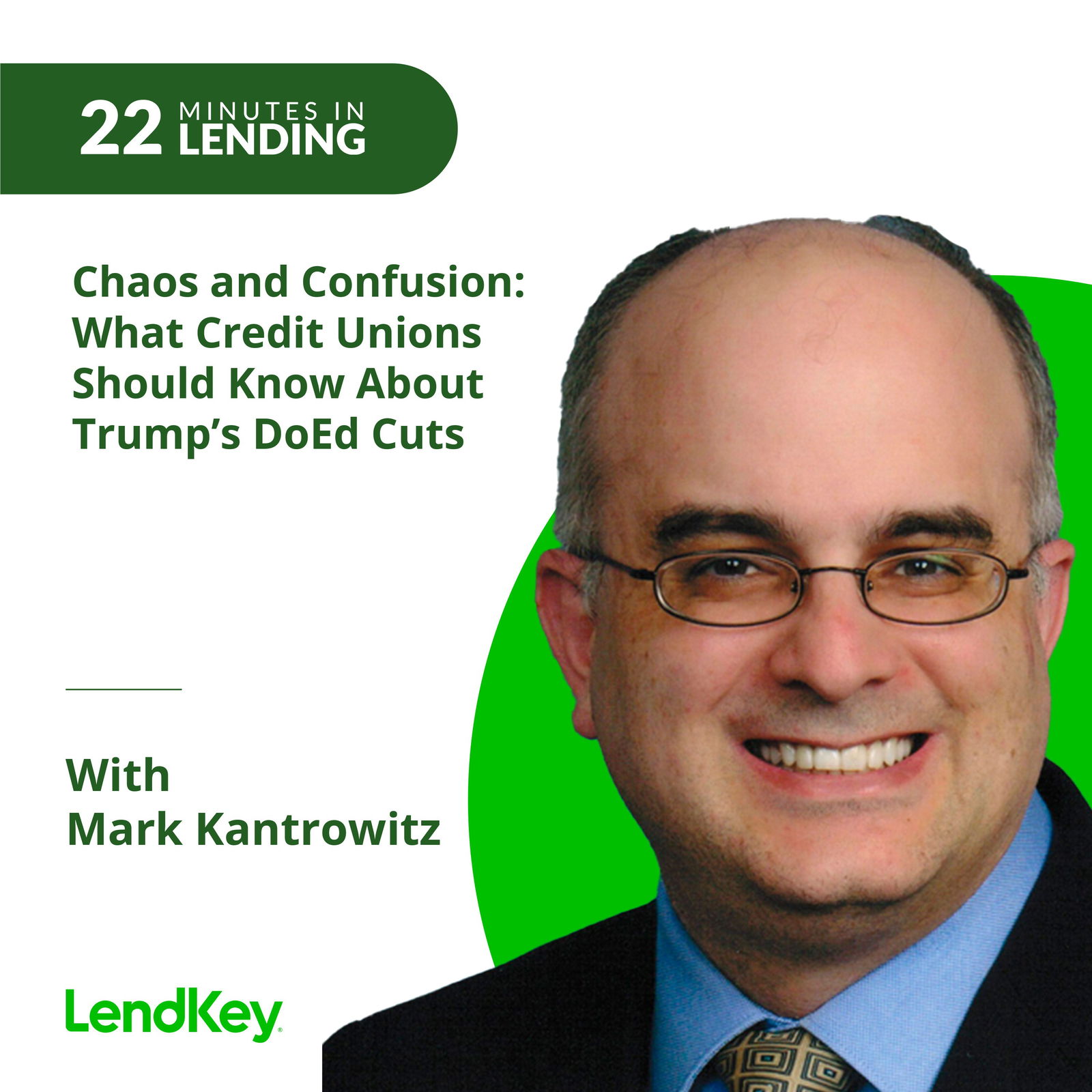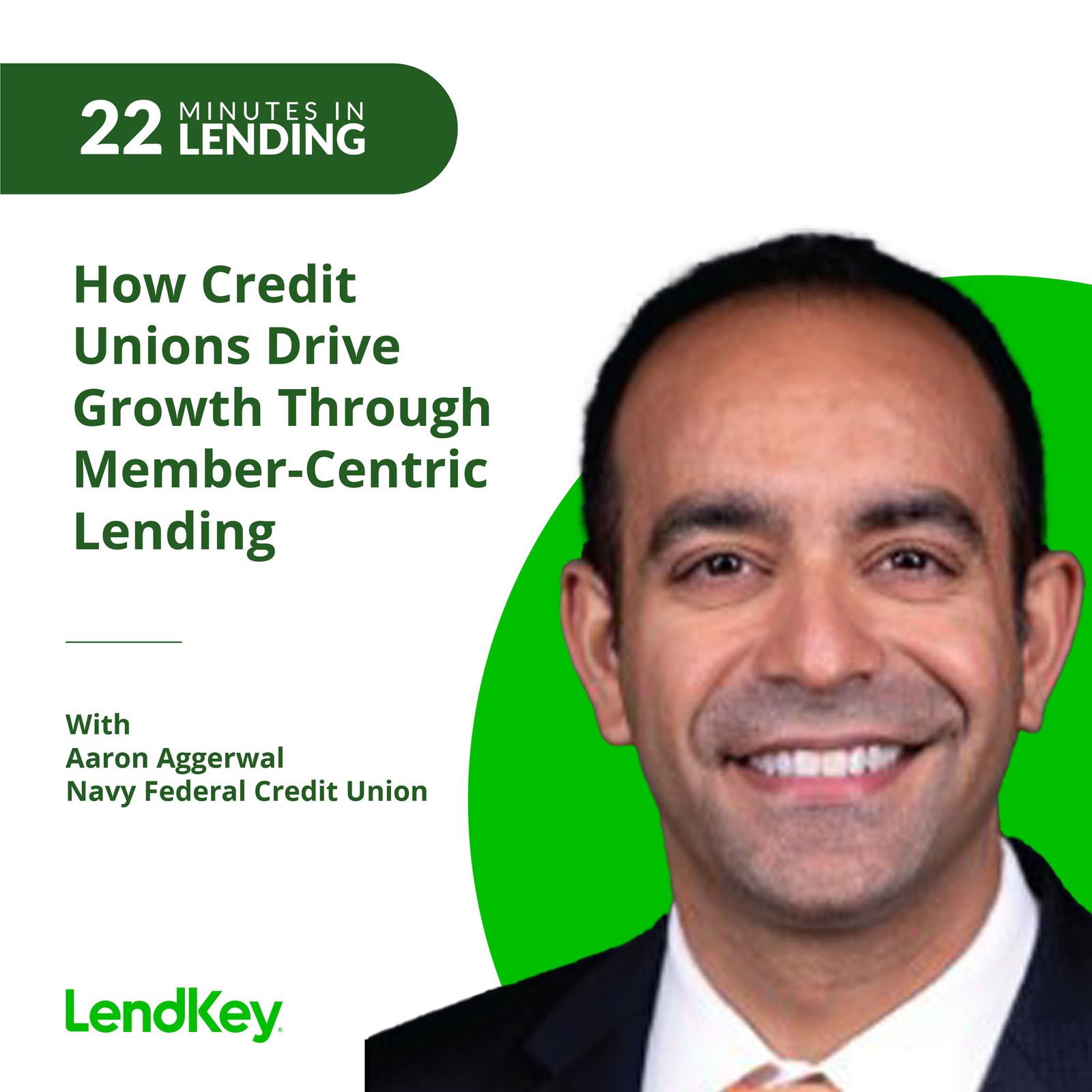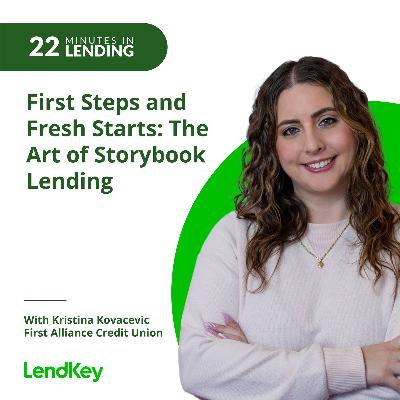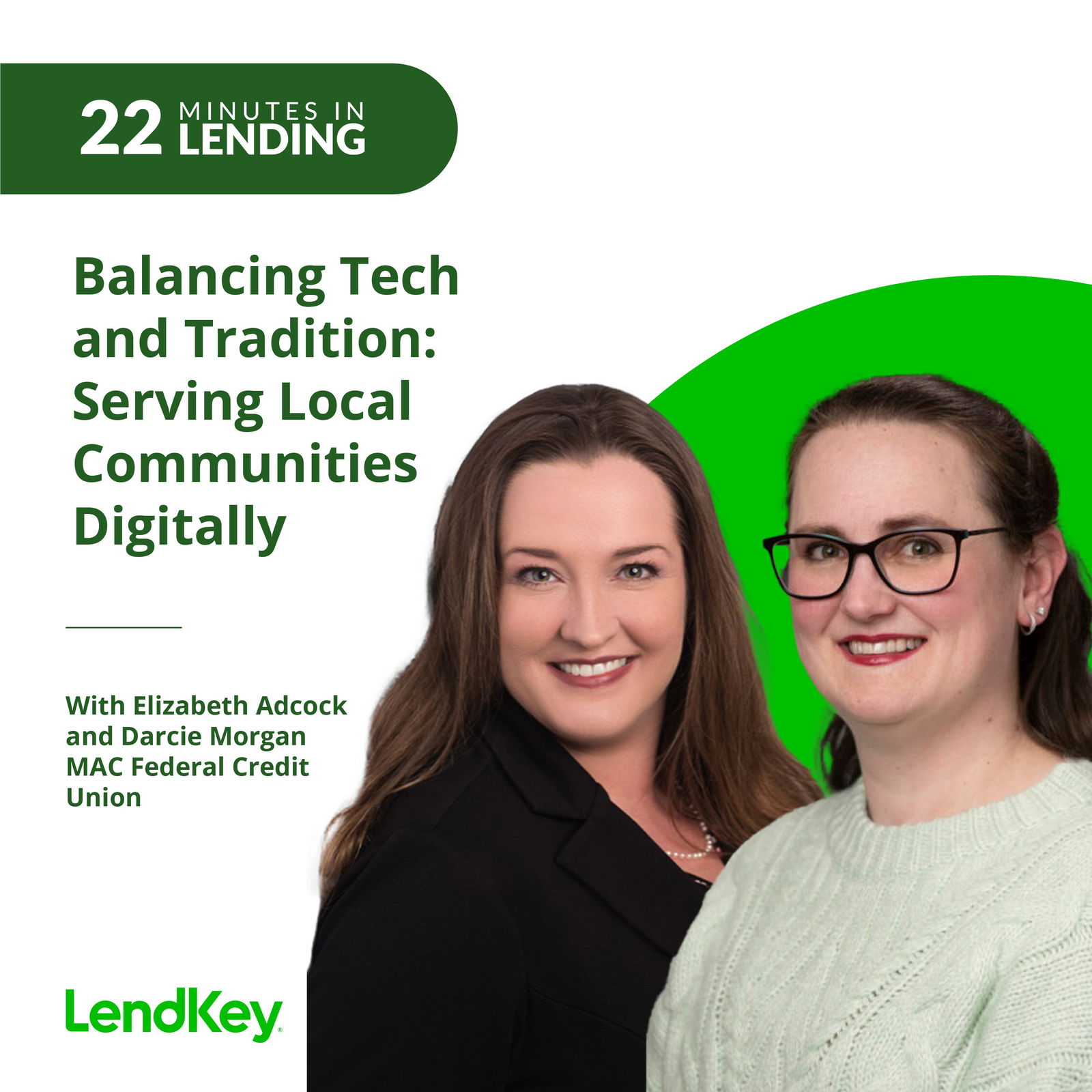Discover 22 Minutes in Lending: Conversations about Credit Unions, Fintech, and Future of Finance
22 Minutes in Lending: Conversations about Credit Unions, Fintech, and Future of Finance

22 Minutes in Lending: Conversations about Credit Unions, Fintech, and Future of Finance
Author: LendKey: Lending Made Simple
Subscribed: 1Played: 0Subscribe
Share
© Copyright 2023
Description
22 Minutes in Lending is a podcast that brings you leading conversations on lending. Join host Vince Passione as he engages with industry leaders and discusses trends and current news in the lending industry. Here, we hone in on how it’s about more than just the balance sheet, and focus on what it takes to build meaningful and lasting lending relationships.
55 Episodes
Reverse
From Wall Street to fintech, James Chemplavil has seen both sides of lending. After 16 years underwriting corporate debt at Barings, he launched Salus to tackle a problem too many hardworking people face: being denied small but critical loans. Now as Founder and CEO, James is helping credit unions use alternative data and automation to extend microloans, attract younger members, and cut charge-offs. In this episode of 22 Minutes in Lending, James joins host Vince Passione to share the Salus origin story, why credit unions are the ideal partners, and how technology is rewriting the future of microfinance.Key Takeaways0:44 – James shares the personal story that pushed him from underwriting billion-dollar debt at Barings to building Salus, designed to fix access to small but critical loans.02:52 – How collaboration, community focus, and tech gaps made credit unions the perfect proving ground for Salus.04:21 – James explains why “cash in vs. cash out” is the new king metric, and how traditional scores miss millions of good borrowers.06:10 – How Salus cuts staff time out of microloan processing, making $500 loans make sense for credit unions.08:25 – The ideal credit union for microloans? Those wanting to pull in Gen Z and those doubling down on community impact.09:34 – Predictive analytics that surface member stress before they default give credit unions a shot to be proactive, not reactive.13:41 – A peek at how transaction data separates two “identical” 620-score borrowers into wildly different risk profiles.15:31 – How Salus slashes charge-offs from 27% to as low as 3%, giving credit unions control over their risk vs. reach.17:52 – James explains why the play isn’t P&L—it’s the lifetime value of turning Gen Z and millennials into members for life.19:59 – Why earned wage access is the front door to member acquisition, deposits, relationships, and sticky growth.21:50 – Salus’ roadmap: helping members graduate from microloans to auto and mortgage loans. Resources Mentioned:Salus: https://www.salusfintech.com/LendKey: https://www.lendkey.com/ Thanks for listening to the 22 Minutes in Lending podcast. If you enjoyed this episode, please leave a 5-star review to help get the word out about the show and be sure to subscribe so you never miss another insightful conversation.#CreditUnions #Fintech #22MinutesInLending #Microloans #LendingInnovation
From banking to startups to serving in Iraq, John Ballantyne has worn many hats. Now as CEO of Tru Treasury, he’s helping more than 70 credit unions build treasury management programs that keep them competitive in a growing commercial lending market. In this episode of 22 Minutes in Lending, John joins host Vince Passione to share the origin story of Tru Treasury, how it’s filling a critical gap for credit unions, and where treasury management is headed in the future.Key Takeaways01:35 – John shares the unique story of launching Tru Treasury in March 2020, just as COVID shuttered the world overnight.04:21 – The advantages of structuring True Treasury as a CUSO, and how collaboration with credit union CEOs shaped the model.05:26 – Today, TruTreasury serves over 70 credit unions in different ways, from consulting to acting as a full outsourced treasury management department.06:56 – Go behind the scenes and hear how Tru Treasury’s three platforms serve credit unions.09:35 – How Tru Treasury steps in during acquisitions to bridge gaps in complex treasury relationships.11:06 – What credit unions need to know about field of membership rules, the 12% cap, and opportunities for commercial lending and deposits.13:11 – Commercial lending trends: growth in C&I and SBA lending, deposit growth, and how commercial deposits can be used to fund commercial loans.15:34 – Untapped opportunities in municipal deposits, and why they’re a natural fit for some credit unions.17:04 –Stablecoin, blockchain, and security innovations shaping the future of payments.21:21 – Looking to 2030: John envisions a modular “commercial banking as a service” model that brings together lending, compliance, and treasury management for credit unions and beyondResources Mentioned:Tru Treasury: https://trutreasury.com/Leverage: https://myleverage.comLendKey: https://www.lendkey.com/ Thanks for listening to the 22 Minutes in Lending podcast. If you enjoyed this episode, please leave a 5-star review to help get the word out about the show and be sure to subscribe so you never miss another insightful conversation. #CreditUnions #Fintech #22MinutesInLending
We’re back with Part 2 of our conversation with Becky Reed, COO at BankSocial. In this episode, Becky maps out the future of lending—from smart contracts and stablecoin-powered car loans to how DAOs could change underwriting and credit union governance. She also shares how boards can (and should) engage with these technologies, why waiting isn’t a strategy, and what the credit union system might look like in 2030.Key Takeaways:00:00Becky walks through a real-world example of how lending could work end-to-end using blockchain, smart contracts, and stablecoin—starting with a member buying a car.05:16"Replacing trust with truth": Becky explains how blockchain transparency removes intermediaries and why BankSocial is non-custodial by design.08:53What if credit unions became DAOs? Becky describes how token-based governance could reshape underwriting, credit committees, and data sharing.12:10Talking tech with your board doesn’t mean teaching blockchain. Becky shares how to frame stablecoin as a payment rail they already understand.15:27Planning season? Becky offers advice on how credit unions can realistically begin exploring crypto, stablecoin, and digital rails, with emphasis on education and execution.18:12Why “waiting to see what happens” is risky. Becky explains the danger of sitting back while others define the future.19:50Becky’s vision for 2030: a grassroots financial renaissance, where DAOs and digital-native credit unions serve tight-knit communities.20:55The best podcast question she’s ever been asked? Listen to hear what it is.Resources Mentioned:BankSocial: https://web.banksocial.io/ LendKey: https://www.lendkey.com/Thanks for listening to the 22 Minutes in Lending podcast. If you enjoyed this episode, please leave a 5-star review to help get the word out about the show and be sure to subscribe so you never miss another insightful conversation.#CreditUnions #Fintech #22MinutesInLending
Becky Reed, COO at BankSocial, joins 22 Minutes in Lending to talk about her long-standing involvement with CUSOs, why cooperation is credit unions’ superpower, and how blockchain, DAOs, and stablecoin are shaping the future of financial services. From her roots leading credit unions and chair emeritus for the NACUSO board, to leading fintech innovation today, Becky unpacks big ideas with clarity and conviction.This is just the first half of a two-part conversation. Don’t miss the next episode, where Becky dives into how these technologies are reshaping lending.Key Takeaways:00:46Becky shares why she believes cooperation is the credit union industry’s superpower, and how the CUSO model reflects that.02:39Is the number of CUSOs growing too fast or not fast enough? Becky explains why more CUSOs (and more differentiation and specialization) is actually a sign of industry health.04:47Are legacy CUSOs at a disadvantage? Becky says no, and explains how traditional and contemporary models are playing different but valuable roles.08:10Becky defines what a Decentralized Autonomous Organization (DAO) is and how BankSocial started as one.11:06Why DAOs matter for the future of credit unions: Becky breaks down how digital governance models can boost transparency, inclusion, and member involvement.13:13Becky dissects the jargon, explaining key terms like blockchain, Bitcoin, and stablecoin.16:32Payments are at the core of financial institutions. Becky explains why stablecoin could become the most efficient payment rail yet and what that means for the future of credit unions. Resources Mentioned:BankSocial: https://web.banksocial.io/ LendKey: https://www.lendkey.com/Thanks for listening to the 22 Minutes in Lending podcast. If you enjoyed this episode, please leave a 5-star review to help get the word out about the show and be sure to subscribe so you never miss another insightful conversation.#CreditUnions #Fintech #22MinutesInLending
How do you modernize a 100-year-old credit union without losing sight of your mission? John Anderson, Chief Lending Officer at Atlanta Postal Credit Union, joins us to share how APCU is navigating dual branding, fintech partnerships, liquidity pressures, and AI adoption—all while staying grounded in its mission to serve both legacy postal-service members and the broader community.Key Highlights01:00 – Overview of Atlanta Postal and its community-focused sub-brand, Center Parc.02:38 –Why and how APCU pivoted to a dual branded approach, and what’s to come in its 100th year.04:11 – Difference between members from the community vs. postal-service members.06:06 – How APCU navigated the liquidity crunch: shifting from CDs to alternative savings products.07:13 – Strategic planning: why APCU avoids “scenario overload” and focuses on actionable risks like USPS changes and GSA lease cuts. 08:43 – The biggest lending challenges APCU is tackling in 2026 planning.09:38 – Is fintech-powered lending just indirect by another name? John shares how it’s different. 10:32 – Digitizing the onboarding process + human follow-up: APCU’s hybrid approach to memberization.12:10 – Servicing plays a key role in building loyalty with members. APCU sees the value in keeping it internal.12:54 – Auto refi isn’t on your members’ radar—but the offers are. A discussion about meeting members where the decision happens and partnering with fintechs that support recapture.15:55 – How APCU is putting AI into action.19:03 – AI as a force multiplier, not a threat: how APCU is freeing up staff for high-value work.20:10 –John shares his mindset shift coming from banking, and what credit unions taught him about serving more than just the safest borrower.21:27 – Advice for up-and-coming Chief Lending Officers.Resources Mentioned:Atlanta Postal Credit Union: https://www.apcu.com/ LendKey: https://www.lendkey.com/Thanks for listening to the 22 Minutes in Lending podcast. If you enjoyed this episode, please leave a 5-star review to help get the word out about the show and be sure to subscribe so you never miss another insightful conversation.#CreditUnions #Fintech #22MinutesInLending
From rebranding to AI-assisted underwriting and member experience, Central One is redefining what it means to be a “wicked local” credit union. In this episode, Devon Lyon, President and CEO, shares how the Massachusetts-based credit union approaches lending and how they’re embracing data-driven accountability.Key takeaways:00:37 – Central One’s rebrand, revamped website, and renewed mission while navigating a highly competitive Massachusetts market.02:27 – How a new AI-assisted underwriting system will helping thin- and no-credit borrowers access credit-building products.05:03 – How education lending works as a gateway to lifelong member relationships.07:30 – Why more credit unions don’t offer private education loans, and how advocacy for regulation changes could help make the juice worth the squeeze.09:05 – Devon makes the case for direct lending.11:14 – How variable-rate mortgages work for Central One’s balance sheet.12:46 – Beyond good times, how the member solutions team supports members before they enter a financial crisis.14:20 – Managing deposit gathering and funding strategy through volatility—lessons learned from 2021’s rate environment.16:15 – “Data isn’t about dashboards—it’s about accountability.” Devon shares his journey to data-driven strategy and how Central One is embedding insights across every department.19:25 – First stop for AI? Underwriting. Devon explains how AI can lead to immediate member impact.20:26 – What’s ahead in 2026? Data visualization.Resources Mentioned:Central One Federal Credit Union: https://www.centralfcu.com/LendKey: https://www.lendkey.com/CU Broadcast: https://www.cubroadcast.com/CULytics: https://culytics.com/Thrive: https://www.anneleggthrive.com/Thanks for listening to the 22 Minutes in Lending podcast. If you enjoyed this episode, please leave a 5-star review to help get the word out about the show and be sure to subscribe so you never miss another insightful conversation.#CreditUnions #Fintech #22MinutesInLending
If your member experience is broken, you’re already losing. As fintechs outpace traditional lenders, CEO Omar Jordan of Coviance believes credit unions have a choice: retreat or run toward the fire. In this episode, he shares how Coviance is helping credit unions shift their mindset, embrace their role in the financial intelligence business, and deliver experiences members can’t help but talk about. It's a call to lead with strategy, and to evolve before irrelevance sets in.Key takeaways:00:38 – Omar Jordan shares the origin story of Coviance, starting with the run he took towards the fire during Great Recession.02:30 – Growth isn’t just about rates or products—it’s about the experience. Omar explains why delivering a fintech-like journey fuels organic growth: today’s members talk.03:49 – A blunt truth: If your member experience is broken, you're irrelevant. Operational efficiencies aren’t optional anymore, they’re required if you want to stay relevant.05:42 – Don’t tell credit unions what to do—ask them what they want to accomplish. Plus, how Coviance measures success. (It’s more than just speed.)08:06 – Are they a fintech? A tech firm? Tech-enabled services provider? Omar breaks down where Coviance fits and how their approach sets them apart.09:18 – With home equity demand rising, fintechs are winning on flexibility and UX. Omar challenges credit unions to shift their mindset from being in the business of managing risk to being in the financial intelligence business.12:26 – Stablecoin isn’t just a buzzword—Omar explains its potential to reshape how funds are disbursed quickly and securely.13:52 – From debit cards for HELOCs to new payment options, Omar spotlights some promising innovation in the HELOC space.16:23 – Everyone’s talking about AI, but few are using it as a strategic multiplier. Omar shares how AI should be used for decision making, not just automation.18:34 – What’s next for Coviance? More innovation, deeper service, and keeping credit unions competitive in a crowded lending space.20:03 – The most underestimated trend right now? The sheer volume of fintech lending happening outside traditional institutions—and what it means for credit unions’ relevance.Resources Mentioned:Coviance: https://www.coviance.com/Thanks for listening to the 22 Minutes in Lending podcast. If you enjoyed this episode, please leave a 5-star review to help get the word out about the show and be sure to subscribe so you never miss another insightful conversation.#CreditUnions #Fintech #22MinutesInLending
Rob Keatts, EVP and Chief Strategy Officer at Chartway Credit Union, joins us to talk about the bold moves Chartway is making—from investing $25 million in branch infrastructure to earning the Juntos Avanzamos designation to better serve Hispanic communities. With a strategy shaped by both data and values, Rob explains how Chartway is using technology, partnerships, and community insight to stay mission-driven and member-focused.Key takeaways:01:01 – How Chartway approaches its supportive role of smaller credit unions in a unique way, including M&A and fostering collaboration and knowledge-sharing—especially when small shops have big ideas worth spreading.02:37 – Why Chartway is investing $25 million in branch infrastructure, and how branches are evolving as centers for education, advice, and connection.05:42 – The strategic role of branches in Chartway’s deposit efforts and why physical presence still matters in a digital world.06:58 – Chartway’s intentional focus on serving Hispanic members and how data led them to partner with Coopera and Inclusiv.10:01 – What it took to earn the Juntos Avanzamos designation: from bilingual staff to cultural fluency, and how Chartway measures success.13:22 – Launching business banking in 2024 to meet growing demand—especially from Hispanic entrepreneurs—and how a digital platform is part of the plan.15:08 – Rob’s tech-to-strategy journey, and why Chartway is betting on fintech partnerships to close the innovation gap with big banks.18:31 – Rethinking credit decisioning with AI: Chartway’s new model aims to say “yes” more often, while guarding against bias.20:19 – Navigating delinquency trends: Rob shares the latest data and where things are starting to stabilize.21:41 – Why now is the moment for credit unions to double down on their mission—and how Chartway is staying anchored to its purpose.Resources Mentioned:Chartway Credit Union: https://www.chartway.com/Coopera Consulting: https://www.cooperaconsulting.com/Inclusiv: https://inclusiv.org/Thanks for listening to the 22 Minutes in Lending podcast. If you enjoyed this episode, please leave a 5-star review to help get the word out about the show and be sure to subscribe so you never miss another insightful conversation.#CreditUnions #Fintech #22MinutesInLending
Whether it’s cybersecurity, liquidity, or finding the right fintech fit, credit unions are navigating a complex landscape with limited resources. Steve Willis explains how LEVERAGE connects nearly 900 credit unions with tailored solutions that don’t just plug holes—they drive meaningful, measurable progress.Key takeaways:00:49: Steve explains the role LEVERAGE plays within the credit union system and how it supports growth, innovation, and even advocacy.03:00: How LEVERAGE identifies the right partners by tuning into credit union pain points and staying close to fintech and financial industry trends.04:57: The kind of support credit unions need in times of uncertainty—and how LEVERAGE helps deliver it.06:12: Finding the sweet spot between digital-forward innovation and the relationship-driven values credit unions are built on.07:50: Helping credit unions navigate a crowded marketplace of fintechs, vendors, and service providers to find what truly moves the needle.11:57: Why size doesn’t limit opportunity—and how smaller credit unions are getting tailored, hands-on support.13:07: The growing responsibility of boards to stay engaged in the rapidly evolving fintech landscape.14:29: Cybersecurity hasn’t fallen off their radar; credit unions just need guidance on effective yet affordable ways to protect themselves.17:46: Exploring liquidity challenges and the solutions LEVERAGE is surfacing to help credit unions adapt.19:03: How LEVERAGE is rolling up its sleeves for small credit unions—offering the right mix of modern tools and practical, proven approaches. Resources Mentioned: https://myleverage.com/ - LEVERAGEThanks for listening to the 22 Minutes in Lending podcast. If you enjoyed this episode, please leave a 5-star review to help get the word out about the show and be sure to subscribe so you never miss another insightful conversation.#CreditUnions #Fintech #22MinutesInLending
In part two of our conversation with Samantha Beeler, president of the League of Credit Unions and Affiliates, we debate taxation and advocacy efforts, discuss the complexities of finding, sourcing and integrating fintech, and unearth a bold vision for the credit union movement’s near and longterm future.Highlights:00.30: The unspoken truth about credit union taxation: That some credit union CEOs would be willing to trade the tax exemption for access to capital markets and simplified M&A regulations.03.57: Alternative tax options and opinions.07.12: How smaller credit unions need greater focus, support, and investment, as they serve their members and communities in unique ways.09.22: Questioning the myth that scale solves all problems, particularly relating to fintech.14.10: Hopes and thoughts on what the future for America’s Credit Unions could look like following Jim Nussle’s retirement announcement.17.57: Beeler’s vision for the future of the credit union system.Resources:www.the-league.coop The League of Credit Unions and AffiliatesThanks for listening to the 22 Minutes in Lending podcast. If you enjoyed this episode, please leave a 5-star review to help get the word out about the show and be sure to subscribe so you never miss another insightful conversation.#CreditUnions #Advocacy #DontTaxMyCreditUnion
Samantha Beeler, President of the League of Credit Unions and Affiliates, joins 22 Minutes in Lending for an unfiltered conversation about the pressures and possibilities facing credit unions today. From board governance to regulatory uncertainty, Samantha shares how credit unions can respond with clarity, collaboration, and confidence—and why “doing business as usual” might just be the greatest form of advocacy.Highlights:01:39: What drove the integration of Virginia into the League, the benefits and risks of multi-state leagues, and the economies of scale it offers for not only the league, but the credit unions it serves.05:09: Discussions around board strength, and director’s understanding as a concern, noting that many directors feel overwhelmed re. cybersecurity, AI, and broader tech trends.09:02: Recapping the recent NCUA upheaval and what credit unions should expect next in the regulatory environment.11:54: Whether it makes sense to simplify the regulatory framework and have a single regulator for all financial institutions, citing examples from other countries.18:49: Advice on how credit unions can navigate the current regulatory environment of rapid change and uncertainty. Resources:www.the-league.coop The League of Credit Unions and AffiliatesThanks for listening to the 22 Minutes in Lending podcast. If you enjoyed this episode, please leave a 5-star review to help get the word out about the show and be sure to subscribe so you never miss another insightful conversation.#CreditUnions #Advocacy #DontTaxMyCreditUnion
Millions of consumers are overpaying on their auto loans, yet few know refinancing is an option. In this episode, Nicholas Goraczkowski, president of iLending, lays out the opportunity for credit unions to boost loan portfolios, improve member financial health, and capture market share in a booming auto refinance space.Key takeaways:00.58: Nick explains the primary reasons consumers don't refinance auto loans—lack of awareness and fear based on negative mortgage refinance experiences.02.52: Insights on the $1.7 trillion auto loan market, and how borrowers seek refinance not just for interest savings, but primarily for payment flexibility.05.13: Why refinanced auto loans typically outperform indirect auto loans.06.25: Definition of "back-end" products (loan protection) and how shifting loan-to-value ratios impact approvals and risk management.09.24: Impact of Federal Reserve interest rate policies on refinance demand, and an overview of the strategic adjustments lenders are making for 2025.12.13: How credit unions can benefit from fintech partnerships to attract new member segments without cannibalizing existing business.14.21: Why efficient, accurate retitling processes are crucial to refinancing success and how iLending approaches this.17.22: Nick’s best practices on transparently selling optional loan protection products, ensuring full regulatory compliance.21.35: Key factors shaping the auto refinance market, including vehicle values, leasing trends, and the competitive landscape.Resources Mentioned:www.ilendingcarloanrefinancing.com iLendingThanks for listening to the 22 Minutes in Lending podcast. If you enjoyed this episode, please leave a 5-star review to help get the word out about the show and be sure to subscribe so you never miss another insightful conversation.#CreditUnions #Fintech #22MinutesInLending #AutoLoans
With relentless technological advances, generational shifts in employment trends, and upended perceptions of “community”, traditional deposit strategies may no longer work for credit unions. In this episode, we speak with Ron Shevlin of Cornerstone Advisors to explore how fintech has paved the way for credit union innovation. Key takeaways:00.55: A decade-long annual study skewed overly positive when conducted in December 2024, but uncertainty about the regulatory environment would likely see credit union leaders respond much more cautiously now, just a few months later.02.55: The biggest myth credit unions tell themselves is that people are their greatest assets–but credit unions live or die through their digital experiences.03.59: How direct deposit relationships may not be the sticky experience credit unions have traditionally thought–and how fintech have turned that theory on its head through smart market segmentation.07.02: Gen Z and Millennials are more savvy about investing than their older counterparts were at the same age, and fintech are capitalizing on that emerging market.09.36: Community banking isn’t dead, but the “community” now means something else; it’s no longer geographically based. Credit unions need to become smarter about how they cater to those niche markets.13.20: Credit unions have a head start on fintech to secure these markets, because they’re already a known entity with market traction.14.10: How credit unions could learn from SoFi’s success and elevate their product strategy.18.30: Digital experience is a credit union’s product.19.44: Should credit unions be investing directly in fintech, and should their members be concerned if the investments don’t deliver profit?22.12: Embedded finance isn’t just about fintech; large institutions like Walmart and Gerber have been using embedded finance to capture and retain market share for years.Resources Mentioned:www.robinhood.com Robin Hoodwww.chime.com Chimepanaceafinancial.com Panaceawww.hustlfinancial.com Vantage West’s Hustlwww.sofi.com SoFiwww.curql.com Curqlwww.trustage.com/ventures TruStage VenturesThanks for listening to the 22 Minutes in Lending podcast. If you enjoyed this episode, please leave a 5-star review to help get the word out about the show and be sure to subscribe so you never miss another insightful conversation.#CreditUnions #Fintech #Lending #GrowthStrategies
Join student lending expert Mark Kantrowitz as he unpacks the drastic Department of Education layoffs, how these changes will impact federal and private student loans—and how credit unions are primed to bridge the gap, and support millions of members through the chaos and confusion.Key takeaways:01.07: An overview of the Trump administration’s proposed cuts to the Department of Education, and the implications on student loan, debt, and forgiveness programs.04.39: Credit unions need to be informed and prepared to help student borrowers navigate any ensuing chaos–particularly if the ombudsman in charge of complaints is curtailed.05.46: The Budget Blueprint that passed the House involves cuts that exceed those already announced by the Trump administration, so more cuts should be anticipated.06.31: How states are not in a position to pick-up the slack and/or take over student lending, so private lenders like credit unions are vital.07.48: Privatizing or selling the trillion-dollar-plus Federal loan balance sheet is not an option, despite what the Trump administration claims.10.05: The implications of these cuts on credit union lending strategies, and how loan consolidation could be a way credit unions can support stressed and financially stretched students.16.21: Credit unions need to prepare for a lot of chaos and confusion–and ensure they’re informed and able to answer questions and provide solutions.Resources Mentioned:www.lendkey.com/lend/private-student-loans LendKey’s student lendingThanks for listening to the 22 Minutes in Lending podcast. If you enjoyed this episode, please leave a 5-star review to help get the word out about the show and be sure to subscribe so you never miss another insightful conversation.#CreditUnions #StudentLending #FinancialAid
Any credit union adding one million new members per year could be forgiven for resting on its laurels–not so for Navy Federal Credit Union. At the nation’s largest credit union, there’s always an opportunity to improve: to increase trust, deepen brand loyalty, and strengthen support for their members. In this episode, we talk with Chief Lending Officer, Aaron Aggerwal, about how relationship-building, financial education, and strategic fintech partnerships have shaped their growth.Timestamps:01:12 – Navy Federal’s explosive growth: 1M new members per year.5:10 – The power of word-of-mouth marketing in financial services.06:22 – Why trust is everything in lending.07:05 – The three pillars of trust in financial services: Choice, value, and simplicity. 10:12 – How Navy Federal educates members on major financial decisions.12:20 – The credit score simulator—helping members make smarter financial choices.15:02 – Fintech partnerships and how they fit into Navy Federal’s strategy. 17:41 – How multi-generational lending builds lifelong relationships.19:05 – The challenges in lending today: Auto loans, mortgage downturns, and balancing risk.21:49 – What’s ahead in 2025 lending trends: Technology, branch expansion, and community focus.24:49 – Final takeaway: Trust is the foundation of Navy Federal’s success.Resources Mentioned:MakingCents Hub: Navy Federal’s financial education platform offering resources to help members navigate key financial decisions.Mission: Credit Confidence® Dashboard: A tool that allows members to monitor their credit score, view their credit report, and simulate changes to understand potential impacts.Personal Finance Counseling: Navy Federal offers free personalized financial counseling to assist members with goal setting, budgeting, and overall financial management.Student Lending Services: In partnership with LendKey, Navy Federal provides online student lending options, including loan consolidation and private student loans.USO Partnership: Navy Federal has committed $9 million to the USO to implement existing programming and establish new initiatives aimed at supporting the military community.Thanks for listening to the 22 Minutes in Lending podcast. If you enjoyed this episode, please leave a 5-star review to help get the word out about the show and be sure to subscribe so you never miss another insightful conversation.#NavyFederal #CreditUnions #FinancialTrust #LendingInnovation #FinancialEducation
Fintech. Disruption. Digital transformation. Panic! Credit unions are constantly behind, struggling to keep up, always at risk of redundancy… Or are they? In this episode, Kristina Kovacevic, AVP of retail services at Minnesota’s First Alliance Credit Union, discusses “Storybook lending”–the art of prioritizing individual members above everything else–and how it is driving her credit union’s long-term growth and sustainability.Key takeaways:00.48: An overview of First Alliance Credit Union–one of an astounding 38 financial institutions serving Rochester, Minnesota.02.54: While the credit union has strong membership and recently expanded into multiple new counties, the organization’s priority focus is “First Start / Fresh Start” members.04.23: What fresh start members–people who have made credit mistakes in their past–can expect from First Alliance, and how the credit union serves them using “Storybook lending”.05.56: How Kristina’s personal experience of moving to the U.S. as a child helps her connect with her membership on a deeper, more personal level.07.09: First Alliance’s unique, qualitative approach to success metrics.08.10: The importance of word-of-mouth referrals to organic membership growth.09.07: How storybook lending supports and enables lending to borrowers who might otherwise be declined through traditional FICO parameters.10.46: While many credit unions are seeing a rise in delinquencies, First Alliance’s hands-on approach to member engagement and storybook lending has kept delinquencies at a minimum.14.00: How fintech partnerships are important–but not the sole focus–for First Alliance’s growth. The credit union works with fintech on everything from member outreach and engagement to underwriting, and getting people out of predatory lending cycles.18.50: “We show up, we listen to your story, we provide opportunities.” The credit union’s simple mission is its most powerful cross-selling tool.20.20: The need to remind credit union employees that their peers and members aren’t born with financial understanding and even the most common terms and products should always be explained.21.12: Times are tough and people are extending themselves too far financially. There’s an opportunity for credit unions to help.Resources Mentioned:www.firstalliancecu.com First Alliancegreenlight.com Greenlightwww.meridianlink.com MeridianLinkeltropy.com Eltropywww.zest.ai Zest AIwww.greenpath.com GreenpathThanks for listening to the 22 Minutes in Lending podcast. If you enjoyed this episode, please leave a 5-star review to help get the word out about the show and be sure to subscribe so you never miss another insightful conversation.#CreditUnions #Lending #22MinutesInLending
Disruption may be the new norm, but have credit unions caught on? In the latest episode of 22 Minutes in Lending, Brian Kaas, president & managing director of TruStage Ventures, discusses the fintech saturation problem, the evolving role of embedded finance, and how credit unions need to break out of the echo chamber to avoid being left behind and realize the benefits of partnerships.Key takeaways:02.13: An overview of TruStage Ventures, its funding structure, and its average investments.03.15: Three key criteria critical to TruStage Ventures making investment decisions: strategic fit and support for credit unions, financial viability, and culture fit.06.26: How the investment strategy has evolved since 2016 to ensure the organization and its portfolio of fintech companies are supporting and sustaining the credit union system.07.50: Fintech has reached a saturation point in the credit union system, and M&A may be the new growth area.10.07: Profitability is a primary concern for credit union executives, and AI-driven back-office automation can often be the solution.12.28: The growth opportunity posed by embedded finance, particularly for credit unions in the auto-lending space.14.59: How TruStage Ventures is making intentional investments to help credit unions capitalize on the embedded finance movement and provide entry-points into relationships with major players like Amazon and Walmart.17.07: When credit unions only talk to other credit unions, it can create an echo chamber. That can mean there’s a misunderstanding or misapprehension of the opportunities posed by fintech.19.02: The importance of Board awareness and support for innovation.20.36: Trust is vital for an emerging fintech to establish credibility with credit unions and gain traction.22.22: What credit unions should be considering before partnering with a fintech of any size or maturity.Resources Mentioned:www.trustage.com/ventures TruStage Venturestrybeem.com Beemwww.americascreditunions.org/events-training/conference/governmental-affairs-conference-2025 GACwww.lendkey.com/podcast/inward-and-upward-driving-member-growth-and-financial-health-with-auto-refi Caribou episode of 22 Minutes in Lendingwww.lendkey.com/podcast/adapting-to-shifting-consumer-behavior-in-auto-lending Origence episode of 22 Minutes in Lendingwww.carsaver.com CarSaverwww.money2020.com Money 20/20Thanks for listening to the 22 Minutes in Lending podcast. If you enjoyed this episode, please leave a 5-star review to help get the word out about the show and be sure to subscribe so you never miss another insightful conversation.#CreditUnions #Lending #Fintech
After years of turbulence, the auto lending market is finally leveling out–and credit unions are primed to capitalize. In the latest 22 Minutes in Lending we talk to Eric Stradley, president of auto refinancing fintech Caribou, about the growth opportunity for credit unions, and the potential positives for millions of consumers.Key takeaways:00.56: The organization’s initial vision to enhance credit unions’ reach and impact through an innovative marketplace.02.49: An overview of the auto refinance market and the potential financial benefits for millions of consumers.03.55: The nuances of auto refinancing vs. traditional mortgage refinancing–namely how credit typically improves during the duration of an auto loan.05.30: The vast majority of auto loans being refinanced were not originated by a credit union, but instead are an opportunity to win market share from bigger banks.06.57: How the turbulence of loan-to-value ratios has skewed underwriting and lending over the last few years, and what the future holds for credit unions.09.09: A major portion of credit unions took a step back from auto lending in the early 2020s but are using refinancing as a lower risk re-entry strategy.11.09: An overview of the Caribou process–how it works for consumers and credit unions, and why that’s a benefit for both parties.14.02: The shifting picture of typical FICO scores for auto refinancing, and how credit unions can reach and engage members that they wouldn’t typically take a risk on.16.53: Auto refinancing provides non-prime members for prime risk, and helps credit unions support members on their upward credit trajectory.17.48: Caribou is essentially national, and is looking for credit union partners to meet consumer demand.19.50: This isn’t about replacing existing credit union services; it’s about augmenting them at a larger scale, reaching potentially millions of more consumers.Resources Mentioned:www.caribou.com Caribouwww.qedinvestors.com QED Investorsus.dealertrack.com Dealertrack Insurance productThanks for listening to the 22 Minutes in Lending podcast. If you enjoyed this episode, please leave a 5-star review to help get the word out about the show and be sure to subscribe so you never miss another insightful conversation.#CreditUnions #AutoLending #GrowthMarketing
From embedded finance and fintech partnerships, to upsell/cross-sell marketing and education lending, in this episode of 22 Minutes in Lending, Casey Mauldin, Chief Revenue and Lending Officer at Jovia Financial Credit Union, discusses the deposit strategies that could help credit unions grow in 2025.Key takeaways:00.40: An overview of Long Island-based credit union, Jovia Financial Credit Union, its field of membership, and the competitive landscape.02.23: The implications of having a dual role that oversees both revenue and lending.04.06: How the cost of funds has influenced the credit union’s deposit growth strategy, and how they navigate significant competition.05.43: Detail on how Jovia has successfully partnered with fintech to drive deposit and membership growth.08.42: The opportunities for smaller credit unions to maximize their marketing efficacy to reach new members and grow deposits.10.40: How education lending can help credit unions reach and engage younger members, grow deposits, and increase loans.15.40: Why business lending has been so critical to Jovia Financial’s growth–so much so that the organization recently launched a business lending CUSO to support other credit unions.19.16: Ongoing uncertainties around office space lending, particularly in highly dense urban areas.Resources Mentioned:www.jovia.org Jovia Financial Credit Unionwww.lendkey.com/podcast/community-lenders-the-best-kept-secret-in-town 22 Minutes in Lending episode with Barry Kirby www.unioncredit.app Union Creditwww.lendkey.com/lend LendKey’s education lending platformThanks for listening to the 22 Minutes in Lending podcast. If you enjoyed this episode, please leave a 5-star review to help get the word out about the show and be sure to subscribe so you never miss another insightful conversation.#CreditUnions #Lending #Deposits #GrowthMarketing
In the latest episode of 22 Minutes in Lending, we’re joined by Elizabeth Adcock and Darcie Morgan of MAC Federal Credit Union who have helped oversee transformational growth at the credit union, driven by a diligent approach to AI and digital investments. Discover how this credit union has bridged the gap between traditional and technical services while still keeping their communities loyal and engaged.Key takeaways:01.35: An overview of MAC FCU and how they strategically expanded their physical footprint to more effectively serve their members.03.00: The rationale behind MAC FCU’s expansion into real estate lending, both commercial and residential.05.36: How MAC FCU’s digital transformation addresses both the needs and wants of its membership.07.34: The infrastructure roadmap and additional investments necessary to upskill and launch MAC FCU’s digital services.08.30: What taking “a foundational approach to AI” means, and how credit unions can safely adopt open source solutions.12.26: Navigating member perceptions, usage, and risks of newly launched AI solutions.14.30: Working in primarily auto-lending to support people with “bumped and bruised” credit.16.19: How credit unions can navigate increasingly high delinquency rates, and support personal and commercial members through financial difficulties.17.42: Increasing process efficiencies and focusing on products-per-member growth are critical growth areas for 2025.Resources Mentioned:www.macfcu.org MAC FCUThanks for listening to the 22 Minutes in Lending podcast. If you enjoyed this episode, please leave a 5-star review to help get the word out about the show and be sure to subscribe so you never miss another insightful conversation.#CreditUnions #Lending #AutoLending #DigitalTransformation




